Gary Clark Jr Guitar Lesson (Bright Lights)
Today I want to share with you an awesome Gary Clark Jr. guitar lesson. We’ll dive deep into his soulful song “Bright Lights”.
This tune is a one-chord blues, and I’ll break down how to play the rhythm and lead step-by-step.
So grab your guitar and let’s jam the blues!
Who wrote Bright Lights?
The song "Bright Lights" was written by Gary Clark Jr. himself. Gary Clark Jr. is an American musician and singer-songwriter known for his skillful guitar playing and blending various genres such as blues, rock, and soul. "Bright Lights" is one of his popular songs and has received critical acclaim for its energetic and soulful sound.
Although "Bright Lights" by Gary Clark Jr. has a similar title to another very famous blues song “Bright Lights, Big City”, by Jimmy Reed. The two songs are very different musically. They only really share similar titles and that’s it. To prove this I also have another lesson explaining the guitar part to Jimmy Reed’s tune, to see for yourself and compare the two songs.
Bright Lights Chords
Now get this: you only need one chord to play “Bright Lights!”
It’s Am. But we are going to play a little extension on the chord, Asus4. This serves as a slight variation, but the chord is still essentially Am. We’ll start on Am, and then move to Amsus4. Here is how I would play each shape.
Both of these chords are played as thumb chords, which means my fretting hand thumb is playing the bass notes on the 6th string.
Am would be played like this:
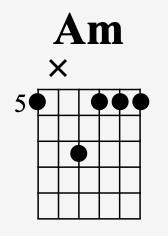
Then still keeping the thumb covering the 6th string, shift your fretting hand ring finger from the 4th string to the third string. This will now land you on an Asus4 like this:
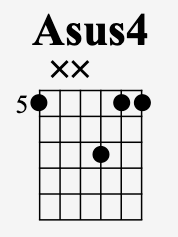
This entire song is all based on what I call a “one-chord blues.” This technique has been used by countless famous blues musicians through the decades.
This type of song relies heavily on rhythmic and melodic variations within a single chord. This can create a compelling musical experience. And that’s exactly what you’ll hear in “Bright Lights”.
While the lack of chord changes may seem limited, one-chord blues can be highly expressive and serve as a foundation for EPIC guitar solos.
Here are a few examples of famous one-chord blues songs:
"Boogie Chillen" by John Lee Hooker: This iconic blues song features a driving rhythm all centered around a single chord. John Lee Hooker's rhythmic guitar playing and distinctive vocal style contribute to its raw and captivating sound.
"Smokestack Lightning" by Howlin' Wolf: This song all revolves around an E7#9 chord, sometimes called the “Jimi Hendrix chord” but Jimi just got this from the blues. The repetitive riff creates a hypnotic and primal atmosphere, complemented by Howlin' Wolf's powerful vocals.
"Mannish Boy" by Muddy Waters: "Mannish Boy" is another great example of a riff style blues all centered around one chord. This song is known for its catchy groove and Muddy Waters' charismatic delivery.
These songs demonstrate how the blues genre can convey a wealth of emotion and musicality using just a single chord. The focus shifts to other elements such as rhythm, melody, lyrics, and instrumental solos to provide variation and interest.
So let’s next talk about the…
Bright Lights Groove And Strumming Pattern
The main rhythm being used in the guitar part for “Bright Lights” is an eighth-note rhythm. This means we will strum 8 times per bar. I play all of them as downstrums. The first 6 strums are played very staccato while the last 2 are played slightly more sustained. This creates a driving and infectious rhythm.
Start by strumming strings 1-4 of the Am chord like this:
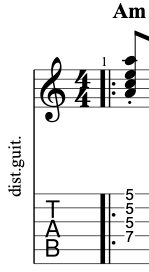
Then after slightly releasing the pressure in your fretting hand, next play the 5th fret on the 6th string. Remember – this note is played with your fretting hand thumb.

Then repeat that pattern 3 more times.

The key to getting this to sound right is in the staccato sound of the chords, and the strong boundary drawn between the treble strings and the bass note. You want it to sound as if it was 2 different musicians. One playing the bass, and another playing the chord.
These last 2 eighth notes of the bar provide a nice relief and variation propelling the groove forward. Altogether measure 1 goes:

From there we’ll stay on the Asus4 chord and repeat the exact same rhythm on the new shape, until the end of the bar where we’ll shift back to the Am chord. Again we’ll play the same rhythm. So that means 6 strums played staccato and then the last 2 ring out more like this:
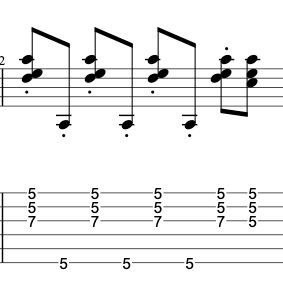
Altogether the groove and strumming pattern are played like this:
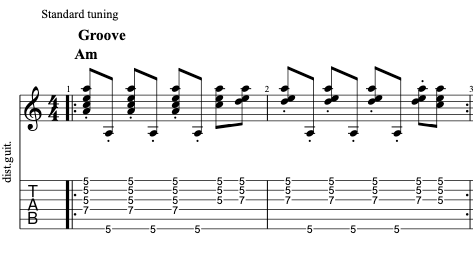
So each shape last 1 bar.
Am (1 bar)
Asus4 (1 bar)
Bright Lights Guitar Solo
As mentioned, because the song is a one-chord blues, this gives players an awesome foundation to play inspiring solos over. The first scale you are going to want to become familiar with is the A minor blues scale. This scale has the notes: A - C - D - Eb - E - G - A, in it.
This scale can be played in the same position as the chord shapes used for the song (5th position) like this:

Here would be the frets to play on each string:
6th string frets = 5, 8
5th string frets = 5, 6, 7
4th string frets = 5, 7
3rd string frets = 5, 7, 8
2nd string frets = 5, 8
1st string frets = 5, 8
These notes are going to get you a bluesy, gritty sound and are great to use to start soloing over “Bright Lights”.
Let’s next take a look at a few licks (in the style of Gary Clark Jr.) that further explore this scale.
Lick #1 starts with a repetitive figure. The purpose of a repetitive figure is to provide a musical anchor, creating a sense of familiarity in the solo. Clark does this by simply playing the 5th fret on the 1st string, and the 8th fret bend on the 2nd string. This short pattern is played 3 times and then the lick finishes off descending down the A minor blues scale.

Lick #2 uses a motif. A motif refers to a short melodic or rhythmic idea that is repeated and developed throughout the solo. It acts as a musical theme or phrase that provides coherence and unity within the improvisation.
Notice how in bar 1 the motif starts by ascending up using notes from the A minor blues scale. Then the same pattern is played again in bar 2 but it ends in a different way.

Motifs in guitar solos can be as simple as a few notes or a distinctive rhythmic pattern. They can also be more complex and intricate, involving melodic sequences or variations. The key characteristic of a motif is its recurrence and transformation throughout the solo.
When a guitarist introduces a motif in a solo, they may repeat it several times to establish it as a recognizable musical idea. This helps to capture the listener's attention and creates a memorable element within their solo.
Once the motif is established, the guitarist can then develop and expand upon it by altering its rhythm, pitch, dynamics, or phrasing.
This variation adds interest and complexity to the solo while still maintaining a connection to the initial motif. This makes your solo sound like you are telling a story.
Lick #3 is short and punchy. This is a great way to play simple lines from the A minor blues scale but it is the RHYTHM that makes it effective.

Conclusion:
In a nutshell, "Bright Lights" by Gary Clark Jr. is a fantastic example of his talent as a musician and his ability to blend genres like blues, rock, and soul. Although it shares a similar title with Jimmy Reed's "Bright Lights, Big City," the two songs are musically distinct.
Clark takes a simple approach by using just one chord, the A minor, to create a mesmerizing one-chord blues. It's incredible how much variation and emotion he puts into the song.
Remember to take it slow and practice both the rhythm parts and the single-note leads. Then when you feel comfortable try playing along with the recording. And for more fun blues guitar lessons check out this post on 101 best blues songs to learn on guitar next!
Like this blog post? Get Jon’s best guitar lessons straight to your inbox.
